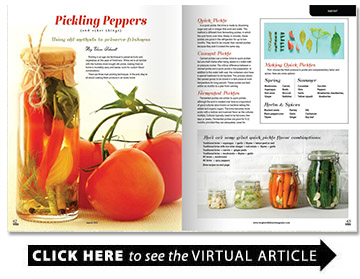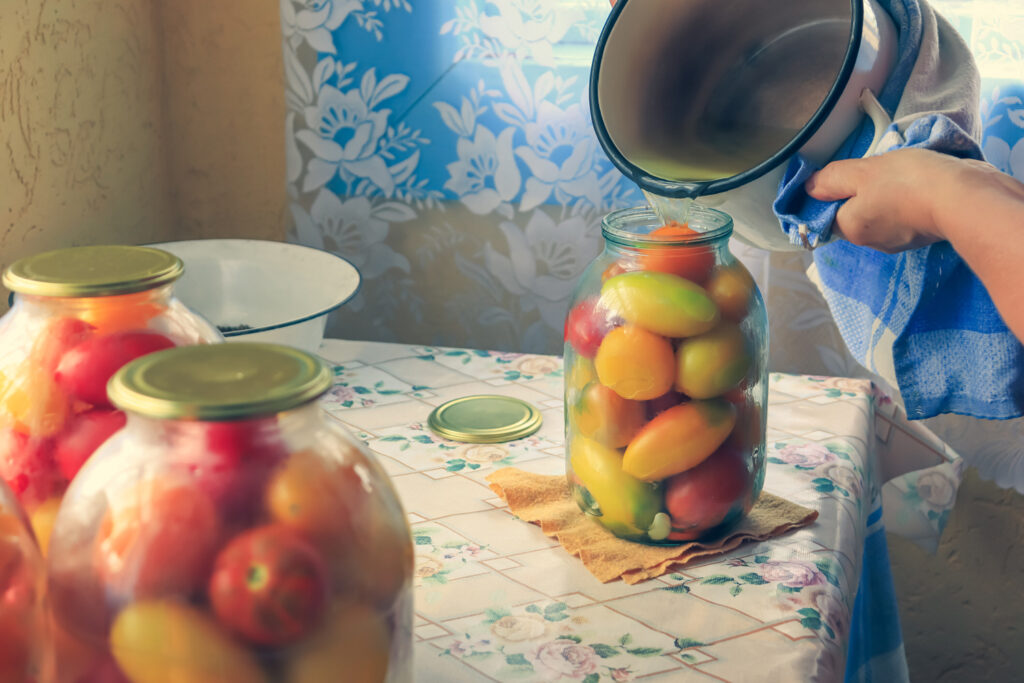Pickling Peppers (and other things)
Using old methods to preserve freshness
BY Eliza Schuett
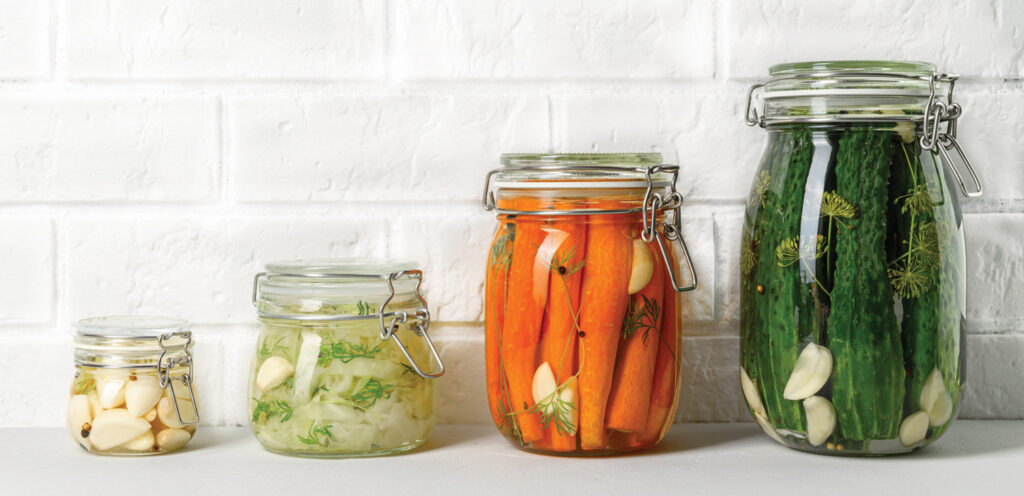
Pickling is an age-old technique to preserve fruits and vegetables at the peak of freshness. While we’re all familiar with the humble store-bought dill pickle, making them at home is incredibly easy and leaves room for custom flavor combinations.
There are three main pickling techniques. In the end, they’re all about soaking fresh produce in an acidic brine.
Quick Pickle
In a quick pickle, the brine is made by dissolving sugar and salt in vinegar (the acid) and water. This method is different from fermenting pickles, in which the acid forms over time. Ready in minutes, these pickles are good in the refrigerator for up to two months. They tend to be crispier than canned pickles because they aren’t cooked the same way.
Canned Pickle
Canned pickles use a similar brine to quick pickles but are shelf-stable after being sealed in a water bath or pressure cooker. The critical difference between a canned pickle and a quick pickle is the preparation. In addition to the water bath seal, the containers also have a special treatment to kill bacteria. This process allows the canned goods to be stored in a dark place at room temperature for long periods. These pickles are best within six months to a year from canning.
Fermented Pickles
Fermented pickles are similar to quick pickles, although the acid is created over time as a byproduct of good cultures (also known as bacteria) eating the added and organic sugars. The brine becomes more acidic with a mellow and nuanced flavor as the cultures multiply. Cultures typically need to be fed every few days or weeks. Fermented pickles are good for 9-12 months, provided they are adequately cared for.
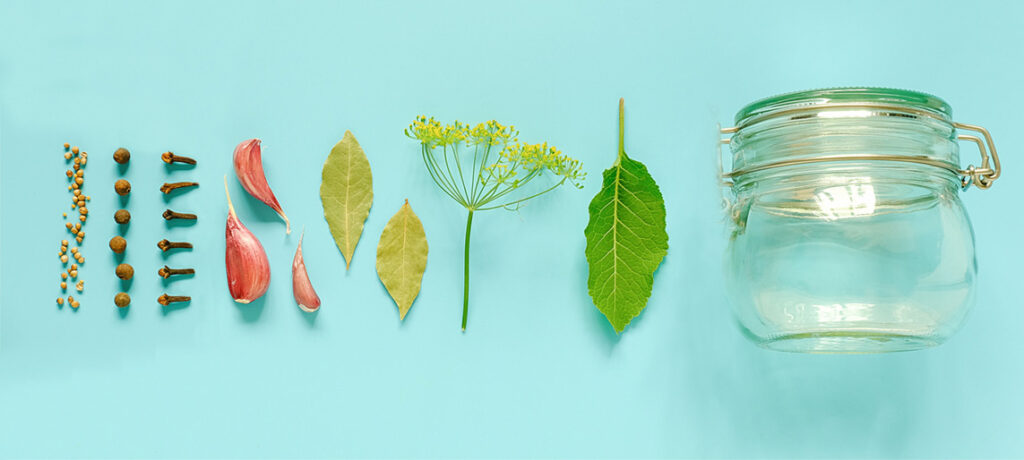
Making Quick Pickles
First, choose the fresh produce to pickle and complementary herbs and spices. Here are some options:
Spring
- Mushrooms
- Asparagus
- Red onion
- Ginger
- Carrots
- Beets
- Broccoli
- Radishes
Summer
- Cucumber
- Okra
- Garlic
- Yellow squash
- Zucchini
- Peppers
- Strawberries, blackberries, blueberries
Herbs & Spices
- Mustard seeds
- Black peppercorns
- Thyme
- Parsley
- Garlic
- Ginger
- Dill
- Cardamom
- Bay leaf
Here are some great quick pickle flavor combinations:
- Traditional brine + asparagus + garlic + thyme + lemon peel or zest
- Traditional brine with rice wine vinegar + red onions + thyme + garlic
- Traditional brine + carrots + ginger peels
- Traditional brine + mushrooms + thyme + garlic
- NC brine + mushrooms
- NC brine + spicy peppers
Now, to Make the Brine!
Traditional Quick Pickling Brine
- 1 cup water
- 1 cup apple cider vinegar
- 1 Tbsp sugar
- ¾ tsp kosher or sea salt
Spicy North Carolina Barbecue Brine
- 1 cup water
- 1 cup apple cider vinegar
- 1-2 Tbsp light brown sugar
- ¾ tsp kosher or sea salt
- Pinch black peppercorns
- 1-2 tsp cayenne
- 1-2 tsp red pepper flakes
- ½ tsp hot sauce
- 1 tsp ketchup (optional)
Heat the brine ingredients and any dried herbs and spices in a small saucepan until salt and sugar dissolve. Then pour over fresh produce in jars, leaving about an inch of space. Cover with a sealable lid and let cool at room temperature for 1 hour, then refrigerate for at least 24 hours so flavors can meld. Mason jars work particularly well.
Pro Tip: To spice up the traditional pickling brine recipe, use ginger peel, fresh or dried herbs, and other aromatics. You can also buy prepackaged pickling spice mixes at the grocery store in the spice aisle.
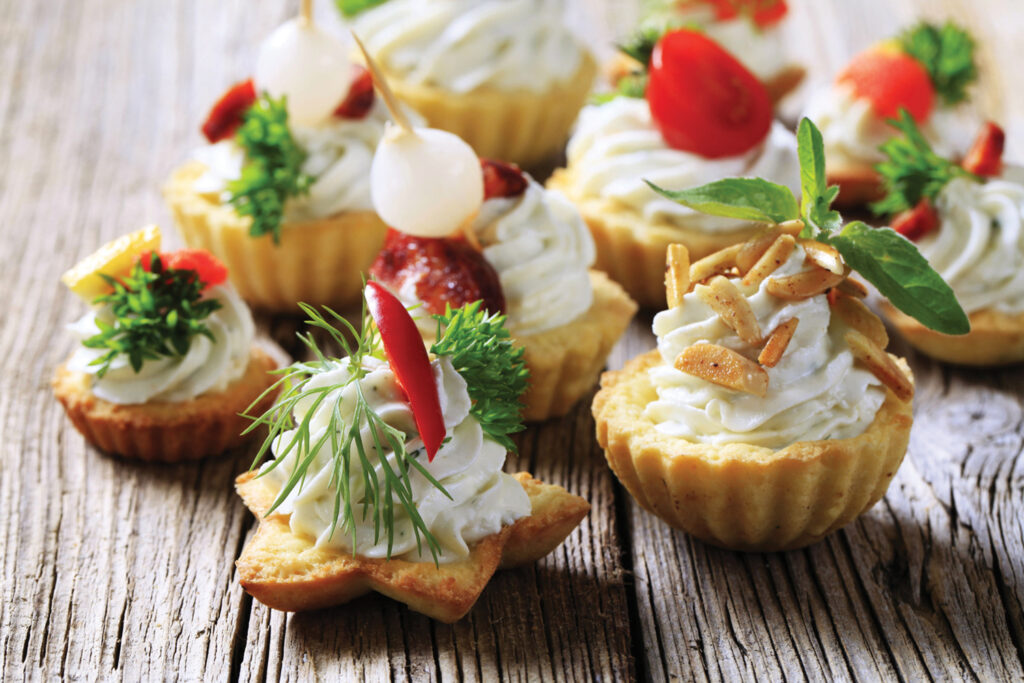
What to Pair with Pickled Veggies
Pickled veggies are a fantastic addition to sandwiches, toasts, tacos and salads. They add a zing of freshness, similar to a lemony salad dressing.
- Cold ricotta pizza with pickled mushrooms or pickled red onion and fresh arugula
- Avocado toast with pickled red onion or pickled carrot ribbons
- Fresh Brussels sprout tacos with pickled red onion or pickled carrot ribbons
- Ricotta toast with spicy pickled mushroom slices or pickled berries
- Sandwich with fresh mozzarella bites (not shreds), greens, carrots, cucumbers, and pickled red onions
- Spring rolls with pickled ginger, avocado, carrot shreds and greens
- Ramen topped with pickled radishes
- Charcuterie board with pickled carrots, cucumbers or peppers to balance out the richer, creamier cheeses
- Nachos with pickled jalapeno slices
- Pickled carrot sticks, cucumbers, and mild peppers make an excellent snack
Brine Variations
- Replace the apple cider vinegar with plain vinegar with a ratio of 2:1 cider to plain. Apple cider vinegar tends to be sweeter than plain vinegar.
- Use other kinds of vinegar or combinations (red wine, rice wine, etc.) depending on what you’re pickling and what herbs are available.
- Adjust spice as needed. If the brine is too spicy, add a little more vinegar, water or sugar to even out.
- Do not use iodized salt — the additives interfere with the pickling process. Stick to kosher or sea salt instead.
- Add a little more sugar for a sweeter flavor. For something more acidic, cut the sugar in half.
